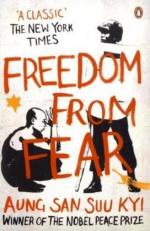|
This section contains 207 words (approx. 1 page at 400 words per page) |

|
Part 1: Section 4 Summary
This section was first published by Tokyo University in 1987. Aung San Suu Kyi began by noting that western influence on Burmese language and literature was obvious by the beginning of the 20th century. As such, it developed with the same aspirations as the nationalism movement. The disintegrating effect of British rule was first felt in lower Burma (Rangoon, on the Irrawaddy Delta, being the center of British rule). Political thinking in the country became increasingly organized during the 1930s but was stopped short by World War II.
One way that a chaotic present influenced Burmese literature was the publication of numerous histories meticulously exploring the country's past. It is neither surprising that many novels were about the struggle for independence nor that some political writing was leftist in orientation. The biggest difference between Burmese and Indian literature is that, having been...
(read more from the Part 1: Section 4 Summary)
|
This section contains 207 words (approx. 1 page at 400 words per page) |

|




